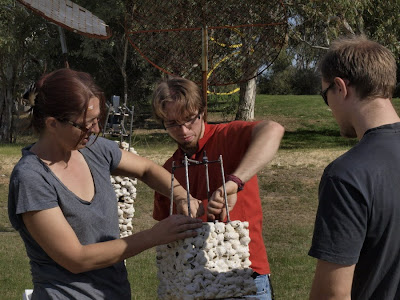Mother
This Easter I was invited to make a work for The Stations of
the Cross exhibition held at Wesley Uniting Church in Perth. I have accepted
after a serious consideration and soul search. To tell
the truth, I didn't even know the meaning of The Stations of the Cross
until I did some research. I accepted without any idea how
to approach the theme, but knowing that it will be a spiritual
challenge as well as artistic one.
Catherine Czerw, curator of the exhibition asked participating artists
to nominate 3 favourite stations in order to allocate each
station to an artist.
Mine was: Station 4: Jesus Meets
His Mother
I
decided to approach the theme from mother’s perspective and examine and depict
the emotions mother would feel watching her son carrying a cross. The subject
is extremely personal and emotional to me as my daughter suffers chronic pain. The
turmoil of emotions felt when you watch your child suffer is hard to put into
words. There is helplessness and sorrow, hopelessness, inadequacy, love, vulnerability,
emptiness and silence.
So
here it is.
Mother is represented
by the larger bowl / vessel / womb that contains / embraces / encircles the smaller
bowl (son) at a tilted angle. She contains and embraces her child and his
cross. Cross is etched, cut and pierced deep into the surface. Shape of the
vessel is reminiscent of holy water font.
In many cultures there
is association of a clay pot with a human body. Potter is a primal artisan who
takes a lump of earth and creates beautiful forms. Vessels.
Body is a vessel that
contains life, emotions, breath, thoughts...
In my studio I have
images by Delhi based photographer Bandeep
Singh. His Antarghata series explores avid interest in the
relationship between human body and earthen pots, and I find them beautiful and
inspirational.
It is interesting to note that Sanskrit word for pot also
means body.
Image for the cross that is etched, cut and pierced deep into the surface of the inner bowl is inspired by the image (appropriately) from the tattoo web site. Unfortunately I did not write the artists name at the time. I would like to acknowledge the artist, so if anybody knows who it is, please let me know.
I like this image as it is complex,multidimensional,formal,architectural and at the same time sketchy, open, unfinished and not totally defined. I did not want the cross to be heavy, overbearing and funerary. I wanted it to hold the gaze and become mandala like, focus for meditative thought.
It is actually mathematical background for a highly decorative celtic cross.
I wanted the bowl to be at the certain height, but definitely not on a plinth, so I made a metal stand.This image is from the opening of the exhibition. The person in the middle is Rev. Don Dowling - now owner of the artwork.



























_resize.jpg)























